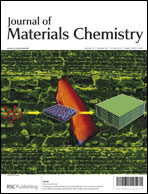Preparation of water-dispersible poly[aniline-co-sodium N-(1-one-butyric acid) aniline]–zinc oxide nanocomposite for utilization in an electrochemical sensor
Abstract
An electrochemical sensor based on an enzymatic poly[aniline-co-sodium N-(1-one-butyric acid) aniline]–zinc oxide (SPAnNa–ZnO) nanocomposite-modified gold electrode was developed for the determination of hydrogen peroxide (H2O2). The SPAnNa–ZnO nanocomposites dispersed stably in an aqueous solution because the small quantity of polyelectrolytic SPAnNa on the ZnO surface prevented nanocomposite aggregation. In addition, the electroactivity and electrochemical behavior of SPAnNa were enhanced in phosphate buffer solution at pH 7.0 by hybridization with spherical ZnO nanoparticles. These negatively charged SPAnNa–ZnO nanocomposites provided a favorable environment for the immobilization of horseradish peroxidase (HRP) by electrostatic interactions. The load quantity of immobilized HRP was approximately 15 wt% on the SPAnNa–ZnO nanocomposite. This non-destructive immobilization maintained the activity of HRP, thereby enabling effective H2O2 detection. The sensor exhibited a linear detection range from 10 μM to 2 mM with a relatively high sensitivity of 519.8 μA mM−1 cm−2 at an applied potential of −0.4 V.
![Graphical abstract: Preparation of water-dispersible poly[aniline-co-sodium N-(1-one-butyric acid) aniline]–zinc oxide nanocomposite for utilization in an electrochemical sensor](/en/Image/Get?imageInfo.ImageType=GA&imageInfo.ImageIdentifier.ManuscriptID=C2JM30775H&imageInfo.ImageIdentifier.Year=2012)

 Please wait while we load your content...
Please wait while we load your content...